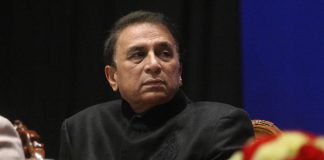SEPTEMBER 2, 2020
Australia fell into its first recession in nearly 30 years as the nation battles a resurgence of the virus with a lockdown in its second-biggest city.
In the U.S., cases and hospitalizations continued to ease in hot spots such as California and Texas, while warnings grew of new outbreaks across America’s Midwest. Across the border, Mexico surpassed 600,000 cases.
A U.S. panel of experts undercut an emergency authorization on plasma treatment issued just days ago by the Food and Drug Administration, saying there’s not enough evidence to recommend the therapy for hospitalized coronavirus patients.
Key Developments:
Global Tracker: Cases surpass 25.5 million; deaths exceed 852,000Vaccine front-runner held back by China’s spat with CanadaU.K. faces October cliff edge with end of wage and loan supportChina in uneven recovery as shoppers splurge, restaurants sufferNYC school reopening delayed to Sept. 21 in union dealVaccine Tracker: Where we are in the race for protection?
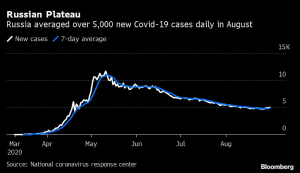
Russian Plateau. – Bloomberg
Australia Has First Recession Since 1991 as Melbourne Lockdown Bites (9:34 a.m. HK)
Australia’s economy, which dodged the 1997 Asian Financial Crisis, the Dot-Com Bubble and the 2008 global financial crisis, fell into its first recession in almost three decades, buffeted by Victoria state’s renewed Covid outbreak and lockdown. Gross domestic product plunged 7% from the first three months of the year, the first back-to-back quarterly declines since 1991, statistics bureau data showed. Economists had forecast a 6% drop.
Australia’s early lifting of restrictions and reopening of its economy is now being offset by an almost two-month lockdown in Melbourne, the nation’s second-largest city with about 5 million people. The central bank and government are working in tandem to try to support the economy, with the former on Tuesday expanding a lending facility to banks to keep credit flowing and the latter extending a labor-market assistance package.
South Korea Measures Halt Rise in Cases (9:30 a.m. HK)
The number of confirmed cases in South Korea fell for a fifth day after peaking at 441 last week, which was the biggest gain since early March. The number of official new confirmed cases was 267 for Sept. 1, the fourth straight day below 300. South Korea imposed stronger social distancing regulations in the greater Seoul area from Aug. 30-Sept. 6.
Fauci Says Positive Data Could End Vaccine Trials Early (9:00 a.m. HK)
A Covid-19 vaccine could be available earlier than expected if clinical trials produce overwhelmingly positive results, Anthony Fauci said in an interview with Kaiser Health News. U.S. stock futures rose after the nation’s top infectious disease official said that an independent panel could halt the trials before their expected conclusion at the end of the year.
The panel could say “the data is so good right now that you can say it’s safe and effective,” Fauci told KHN. He said researchers would have “a moral obligation” to end the trial early and speed the process to give the vaccine to millions.
He said he wasn’t concerned about political pressure to get out a vaccine quickly, stressing that “you’d better be sure you have very good evidence that it is both safe and effective.”
Pregnant Women at Higher Risk of Intensive Care (6:30 a.m. HK)
Mothers-to-be with Covid-19 may be at increased risk of intensive care admission, breathing problems that require the use of a ventilator and giving birth early, researchers said.
Babies born to mothers with the pandemic virus were also at higher risk of needing intensive care, with a quarter admitted to the neonatal unit, according to an analysis that was published in the BMJ medical journal and partly funded by the World Health Organization. However, still birth and newborn death rates were low among these babies, the researchers found.
White House Says CDC Will Halt Evictions (5:19 p.m. NY)
The Trump administration said it will use its quarantine authority to keep renters in their homes during the coronavirus pandemic as a way to prevent an eviction crisis that could worsen economic strains.
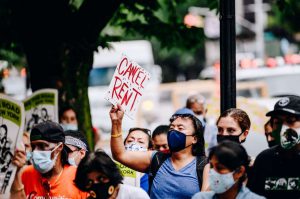
Demonstrators Participate In Nationwide Uprisings Against Evictions. – Photographer: Nina Westervelt/Bloomberg
A demonstrator holds a sign that reads “Cancel Rent” during an eviction strike in Brooklyn, New York, on Sept. 1.
The Centers for Disease Control and Prevention plans to temporarily halt evictions of consumers earning no more than $99,000 a year to prevent the virus from spreading, a senior administration official said Tuesday. The policy will take effect immediately.
The administration is acting unilaterally after failing to reach a deal with lawmakers over another round of stimulus relief funding, aimed in part at keeping renters in their homes.
Texas Hospitalizations Extend Decline (5:08 p.m. NY)
Texas’s Covid-19 hospitalizations fell to 4,144, the lowest since June 23, according to state health department data. The census has been dropping almost continually for the past two weeks and is now down 62% from the July 22 peak.
The Lone Star state added 4,116 new cases that brought the cumulative total diagnoses to 617,333, health department figures showed. Fatalities increased by 145 to 12,681.
Governor Greg Abbott signaled that he may lift restrictions on businesses as soon as next week as hospital admissions drop.
“Since my last orders in July, Covid numbers have declined, most importantly hospitalizations,” Abbott said in a tweet late Monday. “I hope to provide updates next week about next steps.”
Miami ICU Patients at Lowest Since June (4:30 p.m. NY)
Covid-19 patients in Miami-Dade’s intensive-care units and hospitals in general fell to the lowest since late June, according to a report from the county.
There are 208 Covid-19 patients in Miami-Dade’s ICUs as of Tuesday, down from 209 a day earlier, and the number of patients in hospitals fell to 786 from 800. The numbers were close to triple that a month ago. Miami-Dade, Florida’s biggest county, has been the hardest-hit area in the state.
Deaths among Florida residents reached 11,374, an increase of 187, or 1.7%, and the seven-day rolling total was under 1,000 for the eleventh straight day. Deaths often trail infections by weeks, and generally take even longer to be reflected in the data.
San Francisco to Open Hotels, Museums (4:15 p.m. NY)
San Francisco, performing better on virus metrics than other parts of California, plans to open hotels, indoor museums and outdoor entertainment in mid-September, along with elementary schools with approved safety plans, Mayor London Breed said. The city is working toward opening elementary schools without waivers as well as middle schools by mid-October, she said in a tweet.
Indoor salons, tattoo shops and massage parlors likely can resume business by the end of the month, the mayor said. The city today started personal services outdoors and opened indoor malls with limited capacities.
San Francisco is one of nine California counties considered “red,” the second-most restrictive measure in a four-tier system for reopening unveiled by Governor Gavin Newsom last week. Thirty-eight counties are in the tightest “purple” tier — areas that comprise about 87% of the population.
U.S. Cases Rise 0.7% (4 p.m. NY)
Coronavirus cases in the U.S. increased 0.7% as compared with the same time Monday to 6.06 million, according to data collected by Johns Hopkins University and Bloomberg News. The increase matched the average daily gain of 0.7% over the past week. Deaths rose by 0.4% to 184,114.
Arizona reported 507 new cases, a 0.3% increase to 202,342 that was just above the 0.2% rise of the prior seven-day period. The state recorded 15 deaths from Covid-19, bringing the toll to 5,044.California reported 3,712 new cases, the lowest daily tally since mid-June. The state reported an additional 85 deaths, bringing its total to 13,018.West Virginia experienced a 2.6% increase in the number of cases from the same time yesterday, bringing the total to 10,513, according to the data from Johns Hopkins and Bloomberg News.
Fauci Warns on Rising Cases in Midwest (4 p.m.)
Anthony Fauci warned that as Covid-19’s spread in Sun Belt states is starting to ebb, “there are several states that are at risk for surging, namely North Dakota, South Dakota, Iowa, Arkansas, Missouri, Indiana, Illinois.”
In an interview Tuesday, the director of the National Institute of Allergy and Infectious Diseases urged residents to wear masks, socially distance, wash hands and avoid crowds.
“Those states are starting to see an increase in the percent positive of their testing; that is generally predictive that there’s going to be a problem,” Fauci said.
NIH Advisers Say Data Fail to Back Plasma Therapy (4 p.m. NY)
A panel of experts convened by the National Institutes of Health undercut an emergency authorization issued just days ago by the U.S. Food and Drug Administration, saying there’s not enough evidence to recommend use of convalescent plasma for hospitalized coronavirus patients.
The NIH advisers said an analysis of a study showed no difference in seven-day survival among those who received plasma containing high amounts of antibodies. The statement contradicts inflated claims made at a White House press conference a week ago, where Food and Drug Administration Commissioner Stephen Hahn and President Donald Trump said convalescent plasma could cut deaths from the virus by 35%. Hahn subsequently apologized for mischaracterizing the benefits of the therapy.
U.S. Won’t Join WHO-Backed Vaccine Effort: Report (4 p.m. NY)
The Trump administration won’t join a global effort to develop, manufacture and equitably distribute a coronavirus vaccine, in part because the World Health Organization is involved, The Washington Post reported Tuesday.
The plan, co-led by the WHO, the Coalition for Epidemic Preparedness Innovations and Gavi, the vaccine alliance, was of interest to some members of the Trump administration and is backed by traditional U.S. allies, including Japan, Germany and the European Commission, the executive arm of the European Union, according to the newspaper.
But the U.S. won’t participate, in part because the White House doesn’t want to work with the WHO, which President Trump has criticized over what he characterized as its “China-centric” response to the pandemic, the Post said.
U.S. Plans to Ship Abbott Tests to States (3:21 p.m. NY)
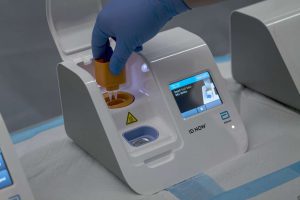
San Francisco International Airport Launches Covid-19 Testing For Employees.- Photographer: David Paul Morris/Bloomberg
An Abbott Laboratories ID NOW rapid Covid-19 test machine.
After purchasing 150 million new rapid Covid tests from Abbott Laboratories, the U.S. government plans to distribute “the overwhelming majority” to states, a top Trump administration official overseeing testing said.
Governors will be able to use the tests to help reopen schools and protect first responders, Brett Giroir told reporters. Distribution is to begin in mid-September, with states coping with natural disasters, such as Louisiana in the midst of hurricane season, first in line, he said.
Most will be shipped to governors, who can allot them “according to their distribution plans,” Giroir said. “We fully, fully want to support them in that.”
California Reports Fewest New Cases Since June (2:40 p.m. NY)
California reported 3,712 new virus cases, the lowest daily tally since mid-June. The increase was less than the 14-day average of 5,366 and reflects ongoing improvement in the state, where average daily infections exceeded 9,000 a month ago.
The average rate of positive tests over the past 14 days was stable at 5.3%, according to state health data. Hospitalizations from the virus decreased 0.7% to 3,849 patients, also the lowest since June.
Still, California reached a grim milestone, crossing 13,000 fatalities from the virus. It recorded an additional 85 deaths yesterday, bringing its total to 13,018.
Health Workers Seen as Priority for U.S. Vaccine (12:45 p.m. NY)
The first doses of a Covid-19 vaccine should go to front-line health-care workers and first responders, followed by people at higher medical risk from the virus, said a group of scientists and academics advising the U.S. government.
Draft guidelines by the National Academies of Science, Engineering and Medicine recommend breaking the population into four groups, with the goal of targeting people at high risk from the virus and at risk of spreading it to others. Group one includes front-line health workers and first responders, followed by people with health conditions that put them at risk as well as older adults in dense living settings.
Nurses Say They’re Short Of Protection Supplies (12:05 p.m. NY)
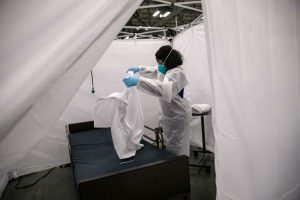
Texas EMS First Responders Face Higher Caseload Amid COVID-19 Pandemic. – Photographer: John Moore/Getty Images
A nurse makes a bed in a Covid-19 isolation bay at the Austin Convention Center in Texas on Aug. 7.
Just days after President Donald Trump praised his administration’s ability to provide personal protective equipment for health-care workers, a national nurses group says their members continue to suffer from shortages.
In a survey of more than 21,000 nurses conducted by the American Nurses Association, a third reported that they were out of or short of N95 masks designed to offer maximum protection in a hospital setting. Almost 60% said they’re re-using single-use protective equipment for five or more days, and 68% said their facilities mandate re-using the supplies.
Courtesy/Source: Bloomberg









































































































